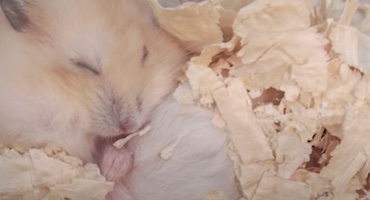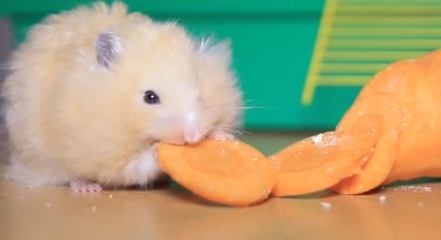 One of the most cherished pets in the world is the hamster. They are cute, little, and simple to care for. Hamsters go into hibernation as the temperature drops, though. They can conserve energy and endure the harsh winter weather thanks to this natural process. We shall delve into the interesting world of hamster hibernation in this post.
One of the most cherished pets in the world is the hamster. They are cute, little, and simple to care for. Hamsters go into hibernation as the temperature drops, though. They can conserve energy and endure the harsh winter weather thanks to this natural process. We shall delve into the interesting world of hamster hibernation in this post.
What is Hamster Hibernation?
Animals can endure the harsh winters by hibernating, which lowers their body temperature and conserve energy (through reducing their metabolic activity). Hamsters who hibernate consume up to 80% less energy and eat less food because of the up to 80% reduction in their energy consumption.
A hamster’s heart rate reduces from an average of 400 beats per minute to as few as 5-10 beats per minute during hibernation. Additionally, their breathing becomes so sluggish that it is hardly noticeable. All of this is done to save energy and lessen the demand for food.
How do Hamsters Hibernate
It’s well known that hamsters are superb planners. They start storing food in their burrows when the temperature drops. One of the most important steps in their preparation for hibernation is the hoarding of food. They will be able to survive the winter when food is in short supply thanks to the food that has been preserved.
Additionally, hamsters begin to construct a unique nest for hibernation. Typically, materials like grass, leaves, and other soft things are used to construct this nest. To ensure that they can sleep soundly during the winter, they make it as cosy as they can.
How long do hamsters hibernate for
A hamster’s duration of sleep during hibernation is influenced by a variety of factors, including age, species, and temperature of the surrounding environment. In the winter, wild hamsters can hibernate for a number of months. However, if a pet hamster lives somewhere warm or has access to enough food and water, they might not sleep as much. When a pet hamster does go into hibernation, it often lasts for a few days to a few weeks before they awaken and begin to move around once more.
When do Hamsters hibernate
When the temperature falls below a specific point during the winter, hamsters in the wild hibernate. Hamsters kept in captivity, nevertheless, might not even hibernate. This is because they don’t have to preserve energy to survive because they are kept in a warm, secure habitat.
It’s unlikely that your hamster will hibernate if you keep it in a consistently warm environment. Your hamster could begin to hibernate if the temperature falls below 60 degrees Fahrenheit, though.
What do hamsters look like when they hibernate
Hamsters that are hibernating appear to be sleeping very deeply. They may close their eyes and breathe quite slowly as they curl up into a ball or lie sprawled out in their nest. It could be difficult to determine whether or not they are alive because their bodies will feel cold and they won’t be moving around much. They could feel rigid or unresponsive if you carefully touch them. Hibernating hamsters need to preserve their energy, thus it’s crucial to avoid disturbing them because doing so can stress and hurt them. The hamster will resume wandering around and behaving normally once it emerges from hibernation.
What temperature do hamsters hibernate
Hamsters hibernate at temperatures below 40 degrees Fahrenheit (4.5 degrees Celsius), on average. This is because hamsters need a cold environment to trigger their hibernation response. Even if winter has arrived, they won’t go into hibernation if their environment is too warm. It’s crucial to keep in mind that domesticated hamsters are not evolved to withstand extremely cold temperatures, making hibernation in an overly cold environment hazardous for them. To avoid unintentionally putting their hamsters into hibernation or suffering from hypothermia, pet owners should make sure that their hamster’s cage is maintained in a steady climate with temperatures ranging between 65 and 75 degrees Fahrenheit (18 to 24 degrees Celsius).
Do hamsters breathe when they hibernate
Is Hibernation Safe for Hamsters?
Hibernation in hamsters is a normal process that helps them survive the winter. However, if the temperature drops too low, it can be hazardous. Your hamster might not be able to survive if the temperature falls below 40 degrees Fahrenheit.
During the winter, it’s crucial to maintain your hamster in a cosy and secure habitat. To keep them alive throughout their hibernating period, you need also make sure they have access to lots of food and water.
Hamsters do not generally hibernate in captivity due to the fact that hibernation is triggered by particular environmental factors. A veterinarian should be consulted if you have concerns and think your hamster could be hibernating in order to make sure they are safe and healthy.
Conclusion
To sum up, the interesting mechanism of hamster hibernation helps these tiny animals endure the severe winter. In order to keep your hamster safe and healthy, it’s crucial to give them a warm and stable habitat, even though it might be deadly if the temperature dips too low. Your hamster can have a happy and healthy life if you give it the right attention and care.
Share
Related Posts
Hamsters make excellent pets, but maintaining their happiness and health takes some effort. Making sure that the hamsters' [...]
Hamsters are absolutely beautiful animals to keep as pets at home. If their tiny adorable faces and gestures [...]
Hamsters are one of the few creatures whose front teeth keep on growing throughout their lives. If the [...]




